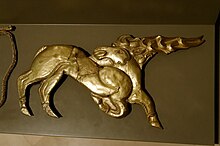Nomaden Eurasia
| Artikel ini adalah bagian dari seri: |
| Topik Indo-Eropa |
|---|
 |
Suku bangsa nomaden Eurasia adalah sekelompok besar suku bangsa nomaden dari Stepa Eurasia, yang sering muncul dalam sejarah sebagai penginvasi Eropa, Timur Tengah dan Tiongkok.

Sebutan generik tersebut ditujukan kepada berbagai kelompok etnis yang pada sepanjang masa tinggal di wilayah stepa Asia Tengah, Mongolia, dan wilayah-wilayah yang sekarang menjadi bagian dari Rusia. Mereka menjinakan kuda pada sekitar tahun 3500 SM, yang meningkatkan kehidupan nomadik,[1][2][3] dan kemudian ekonomi dan budaya mereka meliputi pembuahan kuda, penunggangan kuda dan pastoralisme nomadik; suku bangsa tersebut biasanya terlibat perdagangan dengan suku bangsa yang bermukim di sekitar wilayah stepa.
"Bangsa berkuda" adalah sebuah istilah generalisasi untuk suku bangsa nomaden semacam itu, yang juga terkadang digunakan untuk menyebut suku bangsa pemburu-peramu di Amerika Utara dan Amerika Selatan yang mulai menggunakan kuda setelah bangsa Eropa membawa hewan tersebut ke benua Amerika.
Referensi
sunting- ^ Matossian Shaping World History p. 43
- ^ "What We Theorize – When and Where Domestication Occurred". International Museum of the Horse. Diakses tanggal 2015-01-27.
- ^ "Horsey-aeology, Binary Black Holes, Tracking Red Tides, Fish Re-evolution, Walk Like a Man, Fact or Fiction". Quirks and Quarks Podcast with Bob Macdonald. CBC Radio. 2009-03-07. Diakses tanggal 2010-09-18.
Daftar pustaka
sunting- Amitai, Reuven; Biran, Michal (editors). Mongols, Turks, and others: Eurasian nomads and the sedentary world (Brill's Inner Asian Library, 11). Leiden: Brill, 2005 (ISBN 90-04-14096-4).
- Drews, Robert. Early riders: The beginnings of mounted warfare in Asia and Europe. N.Y.: Routledge, 2004 (ISBN 0-415-32624-9).
- Golden, Peter B. Nomads and their neighbours in the Russian Steppe: Turks, Khazars and Qipchaqs (Variorum Collected Studies). Aldershot: Ashgate, 2003 (ISBN 0-86078-885-7).
- Hildinger, Erik. Warriors of the steppe: A military history of Central Asia, 500 B.C. to A.D. 1700. New York: Sarpedon Publishers, 1997 (hardcover, ISBN 1-885119-43-7); Cambridge, MA: Da Capo Press, 2001(paperback, ISBN 0-306-81065-4).
- Kradin, Nikolay. 2004. Nomadic Empires in Evolutionary Perspective. In Alternatives of Social Evolution. Ed. by N.N. Kradin, A.V. Korotayev, Dmitri Bondarenko, V. de Munck, and P.K. Wason (p. 274–288). Vladivostok: Far Eastern Branch of the Russian Academy of Sciences; reprinted in: The Early State, its Alternatives and Analogues. Ed. by Leonid Grinin et al. (р. 501–524). Volgograd: Uchitel'.
- Kradin, Nikolay N. 2002. Nomadism, Evolution, and World-Systems: Pastoral Societies in Theories of Historical Development. Journal of World-System Research 8: 368–388 Diarsipkan 2008-02-27 di Wayback Machine..
- *Kradin, Nikolay. 2003. Nomadic Empires: Origins, Rise, Decline. In Nomadic Pathways in Social Evolution. Ed. by N.N. Kradin, Dmitri Bondarenko, and T. Barfield (p. 73–87). Moscow: Center for Civilizational Studies, Russian Academy of Sciences.
- *Kradin, Nikolay. 2006. Cultural Complexity of Pastoral Nomads. World Cultures 15: 171–189 Diarsipkan 2012-11-17 di Wayback Machine..
- Kradin, Nikolay. Nomads of Inner Asia in Transition. Moscow: URSS, 2014 (ISBN 978-5-396-00632-4).
- Littauer, Mary A.; Crouwel, Joost H.; Raulwing, Peter (Editor). Selected writings on chariots and other early vehicles, riding and harness (Culture and history of the ancient Near East, 6). Leiden: Brill, 2002 (ISBN 90-04-11799-7).
- Shippey, Thomas "Tom" A. Goths and Huns: The rediscovery of Northern culture in the nineteenth century, in The Medieval legacy: A symposium. Odense: University Press of Southern Denmark, 1981 (ISBN 87-7492-393-5), pp. 51–69.
Pranala luar
sunting- Nomadic Art of the Eastern Eurasian Steppes, an exhibition catalog from The Metropolitan Museum of Art (fully available online as PDF), which contains material on Eurasian nomads
- Center for the Study of Eurasian Nomads Diarsipkan 2020-02-05 di Wayback Machine.